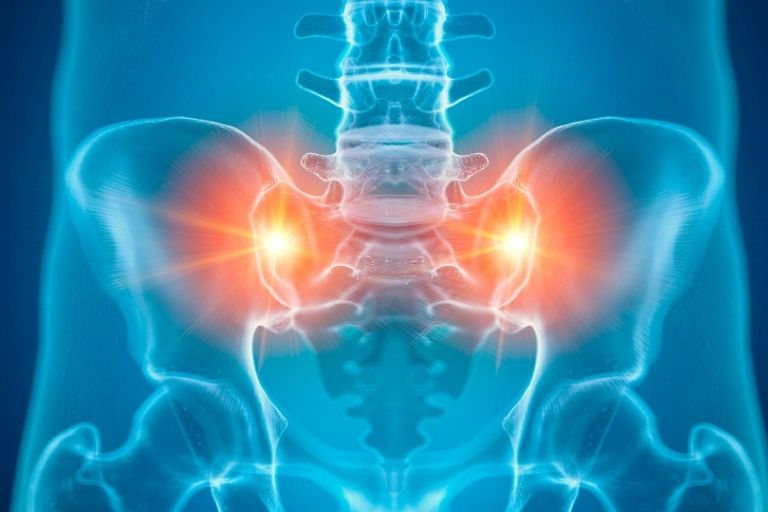Dr. Spine Clinic
Sacroiliac Joint Dysfunction
The sacroiliac joint is the joint between the sacrum and the ilium bones of the pelvis connected by strong ligaments. They carry the entire weight of your upper body when you sit or stand. When affected, a dull sharp pain is felt in your buttocks, thigh, upper back, or groin. The pain is triggered by standing and is more during the morning hours but subsides during the day. This chronic condition is more common than you could imagine. Let us see what exactly causes it.

The Best Sacroiliac Joint Dysfunction Treatment in Bangalore
Causes of Sacroiliac Joint Dysfunction
Inflammation of one or both joints is the ultimate cause of joint dysfunction, it is caused by several conditions that include During aging, the sacroiliac joints gradually wear due to stress exerted over many years. Wearing out of the cartridges causes pain not only to the sacroiliac joints but also to the spine and other joints throughout the body. This condition is known as
Osteoarthritis
Obesity may not seem to affect much but the excess weight of the individual is actually a major factor in sacroiliac joint dysfunction. Weight exerted on the joints causes the wearing up of the ligaments such time within a short period the individual develops Sacroiliac joint dysfunction characterized by sharp pains during movements on the lower back and spine.
Trauma
Trauma is not something many would consider, for instance stepping on a rough surface and jamming the joint. The ligaments supporting the joint may be injured by trauma and it’s just a matter of time before symptoms will begin to show.
Pregnancy
During pregnancy, hormones relax the muscles and ligaments of the sacroiliac joint in preparation for the birthing process. This could cause the joint to slightly slip out of place and it becomes very painful. Luckily, all the pain goes away after pregnancy since the muscles grow stronger again.
Stress
Mechanical stress may not be quite common but it can cause massive pain and changes in your sacroiliac joint over time. Some individuals tend to have severe stiffness. For example, a surgical spinal fusion may increase pressure on the sacroiliac joints making it dysfunctional due to the pressure exerted on it.
Symptoms of Sacroiliac Joint Dysfunction
- General weakness in your arms and legs- it causes a sensation in the lower extremity. You may experience dizziness, tingling, numbness, and mostly a sharp pain even by walking or standing
- The lower back is the most affected part. The lifting of even the lightest weight triggers a sharp pain from the SI joint
redness- the joints turn reddish due to the swollen muscles. - Joint swelling is normal since when the ligaments are affected, the joints tend to swell a little.
Joints become tender and quite weak often you will find it hard to stand or walk. - Limping due to the sour joints which are quite painful when you walk
- Locking of the joint,
- loss of range of motion of the joint
- Experiencing sleepless nights due to pain surges during the night. It makes it hard to do any form of activity.
- Sitting on one side or sitting evenly is one of the most common signs for individuals with SI joint pain. The sharp pains cause a disturbed sitting pattern. They affect the aspect of the patient’s daily normal life.
Treatment for Sacroiliac Joint Dysfunction
Treating sacroiliac joint pain varies with the patients since some respond to oral physical therapy, oral injections, and oral medications.
Brief resting periods help ease the pain since the joint gets time to recover. One should not rest for too long since that would increase or worsen the stiffness of the joint
Applying cold and hot substances on the lower back really helps reduce inflammation and reduce pain. It reduces the muscle tension when you use heat for some time then switch to ice repeatedly until the pain is gone.
Over-the-counter drugs are the most preferred by people to subdue the pain. The patient must be careful since the addiction to such drugs has a very severe side effect. Prescriptions from a professional will help treat the joint.
It is a little rare but through fatal accidents, the sacroiliac joint ligaments could be severely damaged. In such circumstances, surgery is the only way to restore the patient’s joint. Also, braces on the side of wide belts and sacroiliac joint injections help alleviate the pain and restore normal activities.
Stretching of the back muscles helps reduce stress on the SI joint. Strength exercises are the best support for the joints. It creates strong abdominal muscles and a strong pelvis giving maximum support of the sacroiliac joint.
Stationary cycling, running, and water aerobics are an exercise that elevates blood flow and helps heal injured tissues.
Moderate impact aerobics facilitate the healing process and strengthen the sacroiliac joint.
Exercising the sacroiliac joint not only reduces pain but also returns the joint to normal functioning and mobility.
Contact us
Dr. Spine Clinic has 4 state-of-art centres in Bangalore. Please reserve your slot by using the form here. Alternatively, you can call 75 5070 5070 to schedule your appointment.

